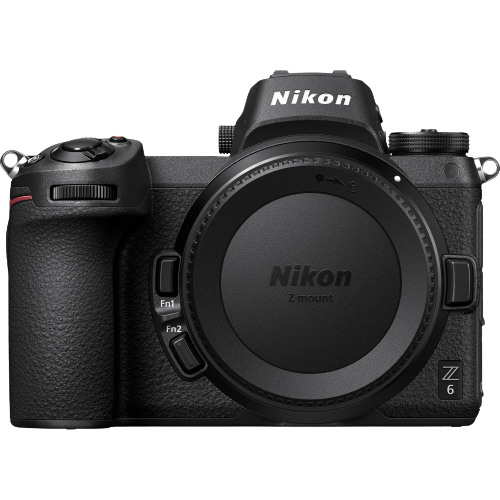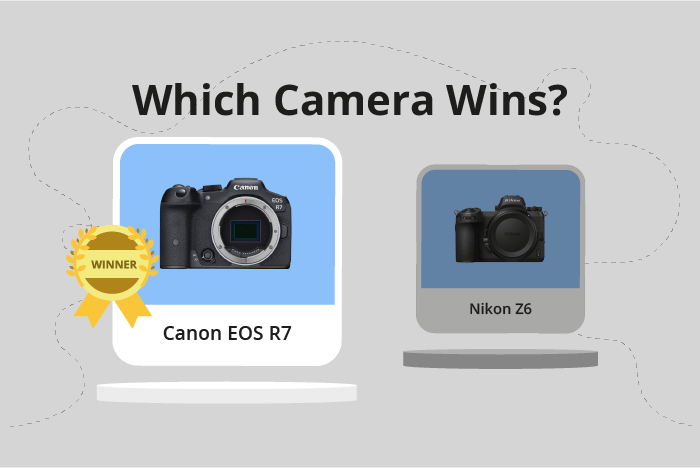Canon EOS R7 vs Nikon Z6 Comparison
Canon EOS R7

Nikon Z6

The Canon EOS R7 takes the lead with a score of 83/100, while the Nikon Z6 follows closely with 81/100. Both cameras are mirrorless and share similar dimensions, with the EOS R7 measuring 132 x 90 x 92mm and the Z6 at 134 x 101 x 68mm. However, the EOS R7 is lighter at 612g, compared to the Z6’s 675g.
The EOS R7 has the advantage of being a newer model, released in 2022, and it comes at a lower launch price of $1500. On the other hand, the Nikon Z6 was released in 2018 and initially cost $2000. Despite the higher price and older release, the Nikon Z6 still delivers excellent performance, as reflected in its close score.
Considering the scores, release dates, and prices, the Canon EOS R7 emerges as a more appealing option for photographers seeking a lightweight, modern, and affordable mirrorless camera. However, the Nikon Z6 remains a strong competitor, offering a high-quality performance that is not far behind the EOS R7.
Canon EOS R7 vs Nikon Z6 Overview and Optics
The Nikon Z6 narrowly wins in the optics comparison with a score of 83/100, while the Canon EOS R7 scores 82/100. Both cameras share several specifications, including CMOS sensor types, image stabilization, and their respective lens mounts (Canon RF and Nikon Z).
The Canon EOS R7 has some advantages over the Nikon Z6. With 33 megapixels, the EOS R7 offers higher resolution images than the Z6’s 24.5 megapixels. Additionally, the R7 has a faster shooting speed of 15 frames per second, compared to the Z6’s 12 frames per second. These factors contribute to the R7’s slightly higher DXOMARK sensor score of 97, compared to the Z6’s score of 95.
On the other hand, the Nikon Z6 has its own strengths. Its full-frame sensor size surpasses the EOS R7’s APS-C sensor, providing better low-light performance and a wider dynamic range. The Z6’s Expeed 6 processor is a powerful and efficient system that delivers high-quality images.
In terms of optics, both cameras perform exceptionally well. The Canon EOS R7’s higher resolution and faster shooting speed make it suitable for capturing detailed images and fast-moving subjects. However, the Nikon Z6’s full-frame sensor and Expeed 6 processor provide excellent low-light performance and overall image quality.
Thus, the choice between these two cameras depends on the photographer’s priorities. If higher resolution and faster shooting speeds are crucial, the Canon EOS R7 is the better option. However, if a full-frame sensor and exceptional low-light performance are more important, the Nikon Z6 is the superior choice.
Canon EOS R7 vs Nikon Z6 Video Performance
The Canon EOS R7 outperforms the Nikon Z6 in video capabilities, scoring 91 out of 100 compared to the Nikon Z6’s score of 83. Both cameras share some common specifications, such as 4K max video resolution and 3840 x 2160 max video dimensions. Additionally, both cameras have built-in time-lapse functionality.
The Canon EOS R7 excels with a higher maximum video frame rate of 120fps, which is twice as fast as the Nikon Z6’s 60fps. This higher frame rate allows for smoother slow-motion footage and more control over the final video output. The Canon EOS R7’s superior frame rate makes it more suitable for professional videographers and content creators who require high-quality, dynamic footage.
While the Nikon Z6 falls short in frame rate, it still offers solid video performance with its 4K resolution, 3840 x 2160 dimensions, and built-in time-lapse functionality. These features make the Nikon Z6 a viable option for casual and amateur videographers who may not require the advanced frame rate capabilities of the Canon EOS R7.
In comparing the video capabilities of these two cameras, the Canon EOS R7 stands out as the better choice for those seeking high-quality, professional-grade video performance due to its 120fps frame rate. The Nikon Z6, while not as powerful in this aspect, remains a strong contender for users who prioritize 4K resolution and time-lapse functionality without the need for advanced frame rates.
Canon EOS R7 vs Nikon Z6 Features and Benefits
The Nikon Z6 emerges as the winner with a feature score of 87/100, slightly surpassing the Canon EOS R7’s score of 85/100. Both cameras share several common features, including a touchscreen, WiFi, and Bluetooth connectivity. Additionally, neither camera is equipped with GPS functionality.
The Nikon Z6 outshines the Canon EOS R7 in terms of screen size and resolution. With a 3.2-inch screen and a resolution of 2,100,000 dots, the Z6 provides a larger, clearer display for photographers to work with. This advantage enhances the user experience, making it easier to compose shots and review images.
On the other hand, the Canon EOS R7 holds an edge over the Nikon Z6 with its flip screen feature. This attribute offers greater flexibility when shooting from various angles and positions, allowing photographers to capture unique perspectives. Despite the smaller screen size of 3 inches and a resolution of 1,620,000 dots, the flip screen compensates for the minor difference in display quality.
Considering the individual strengths of each camera, the Nikon Z6’s larger screen size and higher resolution make it a superior choice for photographers who prioritize display quality. However, the Canon EOS R7’s flip screen feature is a valuable asset for those seeking versatility in framing and composition. Ultimately, the choice between these two cameras depends on the individual preferences and priorities of the photographer.
Canon EOS R7 vs Nikon Z6 Storage and Battery
The Canon EOS R7 outperforms the Nikon Z6 in storage and battery, scoring 79/100 compared to the Z6’s 35/100. Both cameras share the feature of USB charging, but the similarities end there.
The EOS R7 leads with two memory card slots, accepting SD/SDHC/SDXC cards with UHS-II compatibility, providing more storage options and backup capabilities. On the other hand, the Z6 has only one memory card slot, limiting its storage capacity to XQD cards.
Moreover, the EOS R7 boasts an impressive battery life of 660 shots, using the LP-E6NH battery type. In contrast, the Z6 falls short with a battery life of 310 shots, utilizing the EN-EL15b battery type.
Although the Z6 lags behind in this comparison, it still offers USB charging, allowing for convenient power options while on the go.
To sum up, the Canon EOS R7 is the clear winner in terms of storage and battery life, providing photographers with greater flexibility and longevity compared to the Nikon Z6.
Canon EOS R7 vs Nikon Z6 – Our Verdict
Are you still undecided about which camera is right for you? Have a look at these popular comparisons that feature the Canon EOS R7 or the Nikon Z6:

